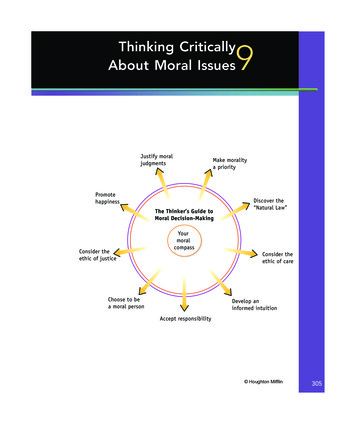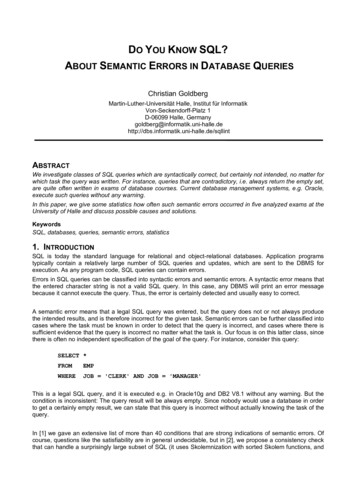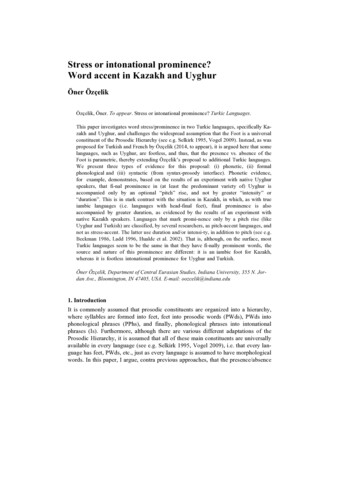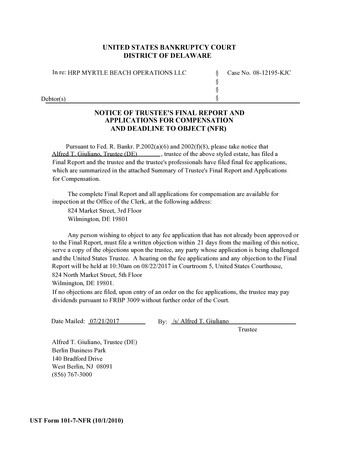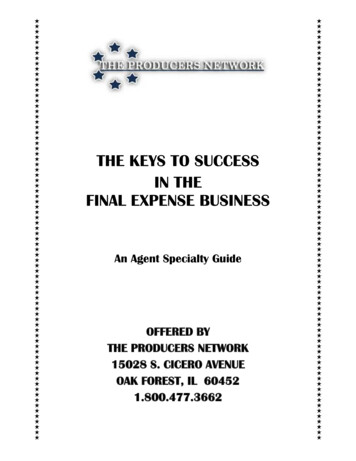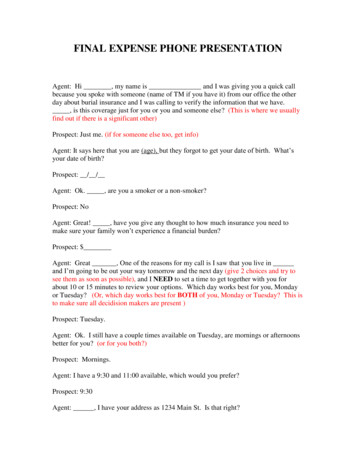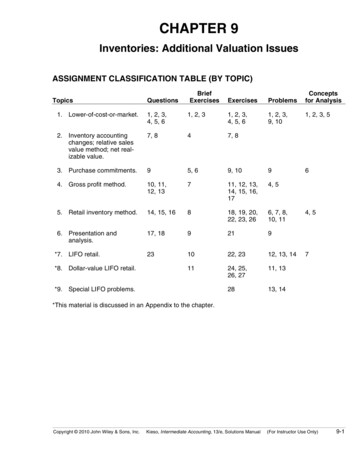
Transcription
CHAPTER 9Inventories: Additional Valuation IssuesASSIGNMENT CLASSIFICATION TABLE (BY TOPIC)TopicsQuestionsBriefExercisesProblems1, 2, 3,9, 101, 2, 3, 561. Lower-of-cost-or-market.1, 2, 3,4, 5, 61, 2, 31, 2, 3,4, 5, 62. Inventory accountingchanges; relative salesvalue method; net realizable value.7, 847, 83. Purchase commitments.95, 69, 1094. Gross profit method.10, 11,12, 13711, 12, 13,14, 15, 16,174, 55. Retail inventory method.14, 15, 16818, 19, 20,22, 23, 266, 7, 8,10, 116. Presentation andanalysis.17, 189219231022, 2312, 13, 141124, 25,26, 2711, 132813, 14*7. LIFO retail.*8. Dollar-value LIFO retail.*9. Special LIFO problems.Conceptsfor AnalysisExercises4, 57*This material is discussed in an Appendix to the chapter.Copyright 2010 John Wiley & Sons, Inc.Kieso, Intermediate Accounting, 13/e, Solutions Manual(For Instructor Use Only)9-1
ASSIGNMENT CLASSIFICATION TABLE (BY LEARNING OBJECTIVE)BriefExercisesLearning ObjectivesExercisesProblems1.Describe and apply the lower-of-cost-or-market rule.1, 2, 31, 2, 3,4, 5, 61, 2, 3,9, 102.Explain when companies value inventories at netrealizable value.1, 2, 31, 2, 3,4, 5, 61, 2, 3,9, 103.Explain when companies use the relative sales valuemethod to value inventories.47, 84.Discuss accounting issues related to purchasecommitments.5, 69, 1095.Determine ending inventory by applying the grossprofit method.711, 12, 13,14, 15, 16,174, 56.Determine ending inventory by applying the retailinventory method.818, 19, 206, 7, 87.Explain how to report and analyze inventory.9219Determine ending inventory by applying the LIFOretail methods.10, 1122, 23, 24,25, 26, 27,2811, 12,13, 14*8.*This material is discussed in an Appendix to the chapter.9-2Copyright 2010 John Wiley & Sons, Inc.Kieso, Intermediate Accounting, 13/e, Solutions Manual(For Instructor Use Only)
ASSIGNMENT CHARACTERISTICS TABLEItemDescriptionLevel urnal entries.Lower-of-cost-or-market—valuation account.Lower-of-cost-or-market—error effect.Relative sales value method.Relative sales value method.Purchase commitments.Purchase commitments.Gross profit method.Gross profit method.Gross profit method.Gross profit method.Gross profit method.Gross profit method.Gross profit method.Retail inventory method.Retail inventory method.Retail inventory method.Analysis of inventories.Retail inventory method—conventional and LIFO.Retail inventory method—conventional and LIFO.Dollar-value LIFO retail.Dollar-value LIFO retail.Conventional retail and dollar-value LIFO retail.Dollar-value LIFO retail.Change to LIFO es for lower-of-cost-or-market—directand allowance.Gross profit method.Gross profit method.Retail inventory method.Retail inventory 3020–30P9-4P9-5P9-6P9-7Copyright 2010 John Wiley & Sons, Inc.Kieso, Intermediate Accounting, 13/e, Solutions ManualTime(minutes)(For Instructor Use Only)9-3
ASSIGNMENT CHARACTERISTICS TABLE (Continued)Level –40P9-10*P9-11*P9-12*P9-13*P9-14Retail inventory method.Statement and note disclosure, LCM, and ional and dollar-value LIFO retail.Retail, LIFO retail, and inventory shortage.Change to LIFO retail.Change to LIFO retail; dollar-value LIFO cost-or-market.Lower-of-cost-or-market.Retail inventory method.Cost determination, LCM, retail method.Purchase commitments.Retail inventory method and LIFO �2510–15ItemP9-8P9-99-4DescriptionCopyright 2010 John Wiley & Sons, Inc.Kieso, Intermediate Accounting, 13/e, Solutions Manual(For Instructor Use Only)
SOLUTIONS TO CODIFICATION EXERCISESCE9-1(a)According to the Master Glossary, Inventory is defined as the aggregate of those items of tangiblepersonal property that have any of the following characteristics:1. Held for sale in the ordinary course of business2. In process of production for such sale3. To be currently consumed in the production of goods or services to be available for sale.The term inventory embraces goods awaiting sale (the merchandise of a trading concern and thefinished goods of a manufacturer), goods in the course of production (work in process), and goodsto be consumed directly or indirectly in production (raw materials and supplies). This definition ofinventories excludes long-term assets subject to depreciation accounting, or goods which, whenput into use, will be so classified. The fact that a depreciable asset is retired from regular use andheld for sale does not indicate that the item should be classified as part of the inventory. Rawmaterials and supplies purchased for production may be used or consumed for the construction oflong-term assets or other purposes not related to production, but the fact that inventory itemsrepresenting a small portion of the total may not be absorbed ultimately in the production processdoes not require separate classification. By trade practice, operating materials and supplies ofcertain types of entities such as oil producers are usually treated as inventory.(b)According to the Master Glossary, the phrase lower-of-cost-or-market, the term market meanscurrent replacement cost (by purchase or by reproduction, as the case may be) provided that itmeets both of the following conditions.1. Market shall not exceed the net realizable value2. Market shall not be less than net realizable value reduced by an allowance for an approximately normal profit margin.(c)According to the Master Glossary, two definitions are provided for the phrase Net RealizableValue1. Estimated selling price in the ordinary course of business less reasonably predictable costs ofcompletion and disposal.2. Valuation of inventories at estimated selling prices in the ordinary course of business, lessreasonably predictable costs of completion, disposal, and transportation.The second definition provides a link to guidance for lower-of-cost-or-market in the agricultural industry(FASB ASC 905-330-35)Growing Crops35-1Costs of growing crops shall be accumulated until the time of harvest. Growing crops shall bereported at the lower-of-cost-or-market. Developing Animals35-2Developing animals to be held for sale shall be valued at the lower-of-cost-or-market.Copyright 2010 John Wiley & Sons, Inc.Kieso, Intermediate Accounting, 13/e, Solutions Manual(For Instructor Use Only)9-5
CE9-1 (Continued) Animals Available and Held for Sale35-3Animals held for sale shall be valued at either of the following:(a) The lower-of-cost-or-market(b) At sales price less estimated costs of disposal, if all the following conditions exist:1. The product has a reliable, readily determinable, and realizable market price.2. The product has relatively insignificant and predictable costs of disposal.3. The product is available for immediate delivery.Inventories of harvested crops and livestock held for sale and commonly referred to as valued atmarket are actually valued at net realizable value. Harvested Crops35-4Inventories of harvested crops shall be valued using the same criteria as animals held for sale inthe preceding paragraph.CE9-2According to FASB ASC 330-10-35-1 through 5: Adjustments to Lower-of-Cost-or-MarketA departure from the cost basis of pricing the inventory is required when the utility of the goods is nolonger as great as their cost. Where there is evidence that the utility of goods, in their disposal in theordinary course of business, will be less than cost, whether due to physical deterioration, obsolescence,changes in price levels, or other causes, the difference shall be recognized as a loss of the currentperiod. This is generally accomplished by stating such goods at a lower level commonly designated asmarket. Thus, in accounting for inventories, a loss shall be recognized whenever the utility of goods isimpaired by damage, deterioration, obsolescence, changes in price levels, or other causes.The measurement of such losses shall be accomplished by applying the rule of pricing inventories atthe lower-of-cost-or-market. This provides a practical means of measuring utility and thereby determining the amount of the loss to be recognized and accounted for in the current period. However, utilityis indicated primarily by the current cost of replacement of the goods as they would be obtained bypurchase or reproduction. In applying the rule, however, judgment must always be exercised and noloss shall be recognized unless the evidence indicates clearly that a loss has been sustained.Replacement or reproduction prices would not be appropriate as a measure of utility when the estimated sales value, reduced by the costs of completion and disposal, is lower, in which case the realizablevalue so determined more appropriately measures utility.In addition, when the evidence indicates that cost will be recovered with an approximately normal profitupon sale in the ordinary course of business, no loss shall be recognized even though replacement orreproduction costs are lower. This might be true, for example, in the case of production under firm salescontracts at fixed prices, or when a reasonable volume of future orders is assured at stable selling prices.In summary, the determination of the amount of the write-off should be based on factors that relate tothe net realizable value of the inventory, not the amount that will maximize the loss in the currentperiod. Note that the sale manager’s proposed accounting is an example of “cookie jar” reserves, asdiscussed in Chapter 4. By writing the inventory down to an unsupported low value, the company canreport higher gross profit and net income in subsequent periods when the inventory is sold.9-6Copyright 2010 John Wiley & Sons, Inc.Kieso, Intermediate Accounting, 13/e, Solutions Manual(For Instructor Use Only)
CE9-3According to FASB ASC 330-10-35-6, if inventory has been the hedged item in a fair value hedge, theinventory’s cost basis used in the lower-of-cost-or-market accounting shall reflect the effect of theadjustments of its carrying amount made pursuant to paragraph 815-25-35-1(b). And, according to 8152-35-1(b), gains and losses on a qualifying fair value hedge shall be accounted for as follows: The gainor loss (that is, the change in fair value) on the hedged item attributable to the hedged risk shall adjustthe carrying amount of the hedged item and be recognized currently in earnings.CE9-4See FASB ASC 210-10-S99—Regulation S-X Rule 5-02, Balance SheetsS99-1 The following is the text of Regulation S-X Rule 5-02, Balance Sheets.The purpose of this rule is to indicate the various line items and certain additional disclosureswhich, if applicable, and except as otherwise permitted by the Commission, should appear onthe face of the balance sheets or related notes filed for the persons to whom this article pertains(see § 210.4–01(a)). ASSETS AND OTHER DEBITS Current Assets, when appropriate [See § 210.4–05] 6. Inventories.– (a) State separately in the balance sheet or in a note thereto, if practicable, the amounts ofmajor classes of inventory such as: 1. Finished goods; 2. inventoried cost relating to long-term contracts or programs (see (d) below and §210.4–05); 3. work in process (see § 210.4–05); 4. raw materials; and 5. supplies.– If the method of calculating a LIFO inventory does not allow for the practical determination ofamounts assigned to major classes of inventory, the amounts of those classes may be statedunder cost flow assumptions other that LIFO with the excess of such total amount over theaggregate LIFO amount shown as a deduction to arrive at the amount of the LIFO inventory.– (b) The basis of determining the amounts shall be stated.If cost is used to determine any portion of the inventory amounts, the description of this methodshall include the nature of the cost elements included in inventory. Elements of cost include,among other items, retained costs representing the excess of manufacturing or production costsover the amounts charged to cost of sales or delivered or in-process units, initial tooling or otherdeferred startup costs, or general and administrative costs.– The method by which amounts are removed from inventory (e.g., average cost, first-in, firstout, last-in, first-out, estimated average cost per unit) shall be described. If the estimatedaverage cost per unit is used as a basis to determine amounts removed from inventory undera total program or similar basis of accounting, the principal assumptions (including, wheremeaningful, the aggregate number of units expected to be delivered under the program, thenumber of units delivered to date and the number of units on order) shall be disclosed.Copyright 2010 John Wiley & Sons, Inc.Kieso, Intermediate Accounting, 13/e, Solutions Manual(For Instructor Use Only)9-7
CE9-4 (Continued)– If any general and administrative costs are charged to inventory, state in a note to thefinancial statements the aggregate amount of the general and administrative costs incurred ineach period and the actual or estimated amount remaining in inventory at the date of eachbalance sheet.– (c)If the LIFO inventory m
Copyright 2010 John Wiley & Sons, Inc. Kieso, Intermediate Accounting, 13/e, Solutions Manual (For Instructor Use Only) 9-9 ANSWERS TO QUESTIONSFile Size: 498KBPage Count: 78
